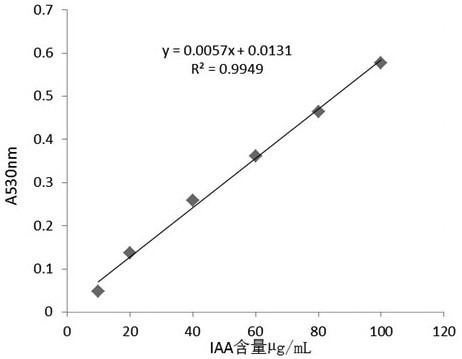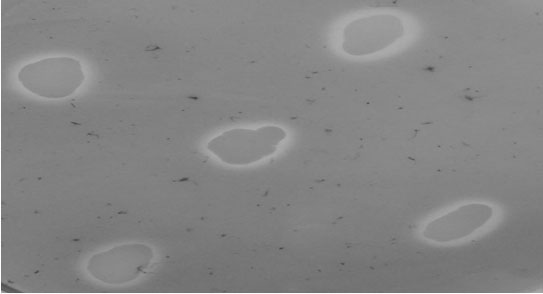A siderophore-producing hydrogen-oxidizing bacterium and its isolation method and application
A technology of hydrogen oxidation and bacteria, applied in microorganism-based methods, biochemical equipment and methods, immobilized on or in inorganic carriers, etc., can solve problems such as few reports
- Summary
- Abstract
- Description
- Claims
- Application Information
AI Technical Summary
Problems solved by technology
Method used
Image
Examples
Embodiment 1
[0040] The separation and screening of embodiment 1 soil microorganism
[0041] The strain was isolated from soybean fields in Bailiang Village, Bailiangzhai Village and Leijia Village, Shuangzhao Town, Xianyang City, Shaanxi Province. Weigh 5g of the rhizosphere soil sample, put into a Erlenmeyer flask with small glass beads and 45mL of sterile water to make 10 -1 Soil suspension, put the soil suspension into a shaker at 180r / min for 30min. Dilute the shaken soil suspension to 10 -11 , and then spread different concentrations of soil suspension on the mineral salt medium, put it into the gas circulation system and cultivate it upside down for 3-4 weeks. Three replicates were set up for each concentration. Colonies of different sizes and shapes were selected from the plate to be streaked and purified on the mineral salt medium, and the purified strains were inoculated on the slope of beef extract and stored in a 4°C refrigerator.
[0042] Inoculate the strain to be tested ...
Embodiment 2
[0045] Example 2 Determination of strain secretion IAA ability
[0046] The hydrogen oxidizing bacteria strain that will be screened, after being activated on the beef extract peptone medium, inoculate in the KingB-Trp medium, wherein the medium contains the L-Trp that final concentration is 100mg / L, then in the shaker 28 Cultivate with shaking at 180r / min for 3 days. Place the culture solution in a centrifuge at 5000r / min for 20min, discard the precipitate, take 0.75mL of the supernatant and mix it with 0.75mL of Salkowski Reagent evenly, react in the dark for 20min, observe the color of the reaction solution, if the reaction solution is pink , the strain can secrete IAA. The OD value of the reaction liquid was measured at 530nm, and the reaction liquid of the sterilized medium and Salkowski Reagent was used as the control group. Substitute the measured OD value into the standard curve to calculate the concentration of IAA produced. In order to ensure the accuracy of the e...
Embodiment 3
[0049] Embodiment 3 bacterial strain siderophore assay
[0050] The determination of siderophores produced by strains is a double-layer CAS plate culture method, and the specific steps are as follows: inoculate the screened hydrogen-oxidizing bacterial strains into LB medium, place them in a shaker at 30°C, and cultivate them at 200r / min for 24 hours. The strains were inoculated into the iron-free MKB liquid medium, placed in a shaker at 30°C, 200r / min iron starvation treatment for 72h, then the strains were inoculated into the iron-free MKB solid medium, placed in a biochemical incubator at 30°C and inverted For culture, add the sterilized upper medium to the lower medium with obvious colonies, and observe the color change around the strains. If orange halos appear around the colonies, siderophores are produced. Otherwise, nothing. The greater the ability of the strain to secrete siderophores, the larger the halo, the darker the color, and the shorter the time of appearance....
PUM
 Login to View More
Login to View More Abstract
Description
Claims
Application Information
 Login to View More
Login to View More - R&D
- Intellectual Property
- Life Sciences
- Materials
- Tech Scout
- Unparalleled Data Quality
- Higher Quality Content
- 60% Fewer Hallucinations
Browse by: Latest US Patents, China's latest patents, Technical Efficacy Thesaurus, Application Domain, Technology Topic, Popular Technical Reports.
© 2025 PatSnap. All rights reserved.Legal|Privacy policy|Modern Slavery Act Transparency Statement|Sitemap|About US| Contact US: help@patsnap.com



